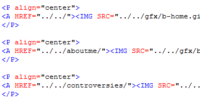Markup
From Just Solve the File Format Problem
Markup languages express the structure and/or presentation of a document through the use of tags, elements, and embedded commands and codes. They are distinguished from programming languages, because instead of giving instructions to be executed, markup elements designate the nature, purpose, or style of text and media which is part of a document.
Contents |
General markup
Markup metaformats
- DTD (Document Type Definition); used to define document formats in markup languages
- XML Schema Definition
Text markup
- Almost Plain Text
- CommonMark (variant of Markdown, attempted to be more standardized)
- LaTeX (User-friendly version of TeX used by mathematicians, computer scientists etc)
- Markdown
- RASH (Research Articles in Simplified HTML)
- reStructuredText
- Scribe
- TEI (Text Encoding Initiative; Specialised dialect of SGML)
- TeX (TeX type-setting language created by Donald Knuth)
- Wiki markup
See also Hypermedia
Web document markup
- HTML (HyperText Markup Language)
- Compressed Markup Language (compact binary form of HTML used in PalmOS)
- Scholarly HTML
- Markdeep (enhanced variant of Markdown intended for browser display via JavaScript)
- OBML (Opera Binary Markup Language)
- WML
- XHTML (Extensible HTML)
See also Web
Specialized markup
- 3DMLW (3D Markup Language for Web)
- AIML (Artificial Intelligence Markup Language)
- AsciiMath
- CML (Chemical Markup Language)
- Fountain (intended for screenplays)
- KFP (preflight profiles for PDF)
- MathML
- Opus Embedded Commands (OEC)
- Rant (programming/markup language for generating text)
- Suggestions [1]
- [x]it! [2]
- OCLC CPD (.cpd)
- Quarto (.qmd)
See also Document, Text-based data, and News media.
Templating engines
See also Programming Languages#Templates, macros, preprocessors, etc.
Links
- Remember the Nineties (complaint about how markup languages are still in use instead of more user-friendly WYSIWYG stuff)
